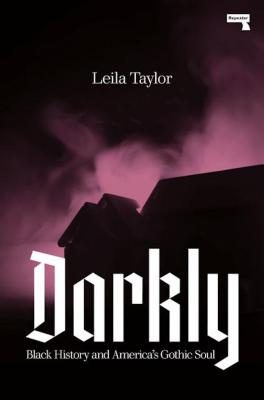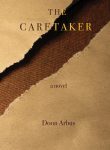 Darkly: Black History and America’s Gothic Soul
Darkly: Black History and America’s Gothic Soul
by Leila Taylor, Restless Books
I quite like the idea of me emerging from my mother’s womb and handing my dad a calling card reading I AM THE NIGHT [‘Leila’ in Arabic]. It makes my morbid predilections inevitable, genetic even—a predisposition to horror movies, black nail polish and a preference for the Cure. I was destined to smoke clove cigarettes and write bad poetry under bridges in the rain. I am Darkness.
—Leila Taylor, Darkly
The sense of the gothic is one of emotional extreme, usually depressive or horrifying. European gothic, using Matthew Gregory Lewis’s The Monk (1796) as my ur-text, replaced the tragic fate and political satire of classical literature with cynicism toward all forms of authority—including and especially the State, Church, and family. In Oedipus Rex, for instance, Oedipus is fated to unwittingly kill his father and marry his mother and face the consequences for violating societal taboos in doing so, even though he was unaware of the relationship. The gothic version of that story would have Oedipus know from the start who the targets of his desires were, that what he desired was evil and wrong—and do it anyhow, the consequences of which would be worse and rightly earned. In gothic literature, the pillars of society have ossified into delusional hypocrisy or coagulated into wormy corruption.
Leila Taylor’s Darkly: Black History and America’s Gothic Soul sets U.S. culture atop a House of Usher-like superstructure of Black oppression, examining slavery, white supremacy, and national trauma as pain and triumph is transformed into music, fashion, literature, and history.
“I started this project,” Taylor writes, “with this intent of researching the Black goth scene and what it was like to be a part of a subculture perceived as being ‘white,’ how it felt to navigate a world where you are twice marginalized when you are the only one in the room.” Although seemingly premised on examining Black appreciation of Goth music, that premise quickly widens to encompass more: “the particulars may morph but the foundation is the same; an anachronistic romanticism, theatrical melancholia, nocturnality, campy morbidity, and the color black.”

Logo for Renaissance High School, Detroit
Taylor’s sense of goth began developing when she lived in Detroit, where she grew up until she was 15. “I remember my first day at Renaissance High School,” she told me in a text exchange, “I saw this guy who looked just like Robert Smith and just fell in love immediately. My scene was pretty limited to my little circle of friends. It was all about Sam’s Jams record store, getting posters and pins and stuff at Noir Leather in Royal Oak and Smash Hits magazine really. I was aware of the [Detroit goth] scene, but kind of too young to be in it. But I did go to concerts—The Cure, The Smiths (I saw them on their Queen is Dead Tour at The Fox Theater), Depeche Mode. There was this music festival that took place every year behind my best friend’s house called Dally in the Alley which was amazing.” She also enjoyed hanging at the DIA, “looking at moody stuff.”
“The thing that felt the most gothic [about Detroit] was the atmosphere. I remember there was this old gothic church downtown that I desperately wanted to live in. Then there were all the ruined houses, these burnt down houses, patches of overgrown empty lots. Victorian mansions with all the windows boarded up. I was too young to think about the economic and social reasons for that decay. It just felt kind of spooky and eerie.”
“There really isn’t a codified genre that’s the equivalent to Southern Gothic for the Midwest or the North,” she said. “But I do think there are themes of existential dread, of the loss of safety and security that is prevalent in American horror. I’m thinking about Shirley Jackson and internalized psychological horror. I think the idea of the ‘monster’ being psychic collective trauma rather than a literal boogieman or vampire is something that is a very modern American kind of gothic. I also think that there are [fears] of colonization, the fears that come with unjust displacement. I’m thinking of that old trope of the house built over an ‘Indian burial ground.’ And there is a particular kind of suburban horror we have in the Midwest. Suburbs created out of white flight that aren’t as safe as we thought they were.”
Her ideas and examples made me wonder if, given the Great Migration (1916-1970) from the rural South to the industrial North (i.e., Detroit, where she grew up), Taylor saw elements of specifically Southern Gothic origins in Detroit, and if so, whether the same Southern tropes are used or instead have been translated / metamorphosed into something (post) industrial, given that she distinguishes between Southern Gothic and post-Industrial American Gothic (using Detroit as her example).
“At Renaissance High School, the school mascot was a Phoenix. Kind of can’t get more goth than that. The Black Gothicity of Detroit is the image of the city (and Black people) rising from the ashes over and over. It always comes back, it never dies. Like Black people there is a resilience to the city. Like that saying “Detroit Hustles Harder.” Well, so do Black people because we have to.”
One of the strong points of Taylor’s book is her effortless blending of the personal with the academic—research, theory, and self-reflection combine in a real, lived consideration of what is. Since many people mistakenly think “academic” means cold and bloodless (when the opposite is almost always the case), I asked Taylor what she would you say to somebody who, though smart and talented, is leery that some passionate part of themselves will be somehow neutered by scholastic training?
“Academic writing requires a kind of rigor by nature, and a career in academia requires being able to prove that you’ve mastered that kind of writing and the ability to slide your work into the discourse. You have to prove that what you’re saying is important and that you are the person to say it.
“Before I went back to grad school, I gave a paper at an academic conference as an ‘independent scholar,’ and after listening to the other talks I realized I didn’t know what the fuck I was doing, so I went back to school to learn.
“I read more, I learned more. My ideas got richer and deeper and more complex and I developed the skills needed for this kind of critical thinking. So when I was writing my book, I was able to use what I learned to write the way I wanted to. I never wanted to write for an academic audience. I don’t want to be in academia. I don’t want my writing to be only accessible on Jstor or in an $80 journal. And I don’t like academic writing. It’s alienating, but I wanted to learn the rules so I could break them. Having a little bit of training (for lack of a better word) in theory gave me the foundation to do what I wanted to do.”
Taylor’s book is wide-ranging and deep, academic and personal, and highly recommended.
 Sentimental Doubts
Sentimental Doubts
by Teresa Wilms Montt (Jessica Sequeira, trans.) Snuggly Books
Leila Taylor’s Darkly left me wondering whether the gothic might not also have parallels in South American literature, in particular—following Taylor’s lead—African-South American experience. Martinique author Patrick Chamoiseau (whose book collaboration with Rodolphe Hammadi, French Guiana: Memory Traces of the Penal Colony, I reviewed recently, may be one who has come closest to exploring that idea under the umbrella of “Creoleness,” “which in the case of the Caribbean, refers to the blending of African, Polynesian, and Asian cultures with that of their European colonizers. This idea of Creoleness contrasts the idea of ‘Americanness’ in that it existed prior to America, and that ‘Americanness’ excludes it interaction with the indigenous population.”
While goth is shock wrapped in a mantle of world-weariness, it is also very much a young person’s genre: Lewis was 21 when he wrote The Monk, and Mary Shelley was 19 when she wrote Frankenstein (itself very much a teenage story of painful self-consciousness and rejection of society). The white experience of South American Gothic in its off-shoot form, Decadence, can be found in Teresa Wilms Montt’s small body of works (she was 24 when this was published):

Teresa Wilms Montt (8 September 1893 – 24 December 1921)
Hats give me the impression of cut-off, mummified heads, and the ones with colorful dangling cords make me imagine heads pulled off by a brutal hand, still attached by a bloody vein.
I can never see a pair of gloves without imagining them to be the skin of preserved hands; and in those of a yellow color, I see something revolting that is beginning to rot.
How I loathe the items of clothing left on the bed, forgotten: there’s a great parallel between them and the dead.
Once, in an asylum, I saw a mad woman who was dead, and she looked just like a violet rag tossed into a coffin.
—Teresa Wilms Montt, Sentimental Doubts
Decadent literature uses protagonists for whom the larger, societal moral decay is often internalized as manic obsessions over morbid thoughts and actions, toward the self and others. Given its susceptibility to sophistry, then, some forms of Decadence can also be read as forms of privilege: the characters are in situations, or create situations for themselves, that allow emotionally and physically destructive indulgence.
However, Teresa Wilms Montt (1893–1921), for instance, came from a wealthy Chilean family and had a private home education, but escaped bourgeois trappings nonetheless—marrying at 17 against her family’s wishes and being thrown into a convent as punishment for having an affair with her husband’s cousin—but only after discovering leftist politics. The poet Vicente Huidobro helped her escape the convent and took her to Buenos Aires in 1916, where she met the writers Borges and Victoria Ocampo (sister of Sylvia Ocampo).
The following year, 1917, she wrote Sentimental Doubts, a sequence of vignettes on pain, loss, love, eros, spiritual loss, and so forth. After all, she was now permanently separated from her children, husband, and parents, punished for desire. She died at 28 from a drug overdose.
[Editor’s note]: The Chilean film Teresa on the life of Teresa Wilms Montt was released and directed by Tatiana Gaviola in 2008. Her poetry can be found in the collection: In the Stillness of Marble (1917), also published by Snuggly.
 Hauntings
Hauntings
by Edouard Dujardin (Brian Stableford, trans.) Snuggly Books
Another author of manic obsessions, Edouard Dujardin is remembered now primarily for his novel Les Lauriers sont coupés, credited as the first stream-of-consciousness novel (1887!), and thus a direct literary forebear to Joyce’s Ulysses. Dujardin’s book Hauntings (1886) is presented in Brian Stableford’s Introduction as the immediately preceding step in the development of stream-of-consciousness. But given the frequent use of manic monologues in the stories that comprise Hauntings, I would also suggest that one can read Dujardin as a step to Joyce after Poe (cf, “The Tell-Tale Heart,” “The Raven”).
A profound, radical sense of doubt dooms many of Hauntings’ protagonists: One man, who has lived through years of (what we would now call) psychotic episodes now wonders, since his hallucinations appeared as real to him as what he sees in his current “sane” state, on what basis he could possibly know if he’s really sane—or that what he endured before was actually a hallucination? Another man—whose first adventure in love ended with the woman killed in childbirth and the baby abandoned at a hospital—distracts himself from the shame of his youth by devoting his time and attention work. After 18 years of this, at the age of 44, he decides to marry (and the woman must (inexplicably) be only 18 years old), just to find himself unable to complete the seduction of any woman he’s matched with, because he’s afraid she might be the daughter he abandoned. (Cf. Beryl Bainbridge’s An Awfully Big Adventure for a modern treatment of that theme). . . An erudite atheist fears he’s made the wrong choice, despite his dismissal of all arguments of faith. . . A young seminarian’s vows of chastity and refusal to masturbate (both clearly at odds with the lusty physique God has blessed him with) climax in a stroke at the end of his first sermon as a priest (which, for the paralysis, at least, reminded me of Joyce’s “The Sisters.”) . . And so forth.
A hundred and thirty years on, the emotional force of these monologues can seem shrill and teen-angsty, despite—or because of—the intellectual pedigree each narrator claims—an assurance that they are above it all (i.e., in possession of such vast amounts of knowledge as to place them far beyond the plebian realm of “emotion”), I suspect the mood Dujardin was attempting to recreate on the page (and one of the first to do so) was the mind of a man (always) who, despite having mastered the art and science of reason, finds that doubt, one single doubt—the unanswered question whose answer transcends reason—has destroyed his entire intellectual edifice. What today’s reader has to transcend is our own time and place, where doubt and uncertainty are both on tap, fresh every day. The reader has to overcome the cynicism of today to understand the cynicism of yesterday, which—as the lyrics from the “Love Boat” theme song would have it—was once “exciting and new.” In the 1880s, Symbolists and Decadents could ardently yearn for an existential dread that hadn’t yet become a marketing ploy for Big Pharma and advertisers. Think of Hauntings as letters from the Land of Dread, when it was still largely terra incognito for literature.
 Decadent Prose Pieces
Decadent Prose Pieces
by Léo Trézenik (Brian Stableford, trans.), Snuggly Books
Because Decadence can be strident about depression, ennui, and weltschmertz, it is never too far from comedy, a full-immersion in bad taste. And “bad taste” usually means talking about things decent people shouldn’t talk about. By the late 19th-century, literature’s nascent Decadent movement had enough room to turn the yawns of ennui by anti-bourgeoisie bored of life into cynical, morbid laughter at the causes of that boredom—usually the result of an author’s assumed intellectual superiority over mere sensual pleasures (i.e., the pleasures J-K Huysmans’s protagonists would take). Thus, the short sketches that make up this slim volume—most are only a page-and-a-half long—combine Joyce’s sense of epiphany (“a sudden spiritual manifestation, whether in the vulgarity of speech or of gesture or in a memorable phase of the mind itself”) with the bleakness of cartoons by Charles Addams and Joan Cornellà. By today’s standards, nothing here would raise an eyebrow—the stories are safe as milk—but given that their point was to take members of society down a peg or two, Trézenik’s cynical evisceration of social hypocrisies was seen as bad taste—which, John Waters, will tell you, is the whole point of comedy.
 Box Hill
Box Hill
By Adam Mars-Jones, New Directions
A short, affecting account of relationship between two men about 10 years apart in age. Beginning on the day Colin turns 18 and ending six years later with Ray’s death, Colin’s relationship to Ray resembles that of his (Colin’s) father to his mother. Both relationships are based on unspoken rules and hierarchies, and to outsiders probably appear as a couple merely cordial toward each other. And for the four of them, they each knew a love often painful and confusing yet as fulfilling as they could hope for.
At the end, Colin learns to live by and for himself after the one person he lived for dies, as does his mother after the one person who lived for her dies.
 The Caretaker
The Caretaker
by Doon Arbus, New Directions
The Caretaker narrates the tale of a bright, unmoored, unnamed protagonist who, midway through life’s path, discovers Stuff, a book by one Charles Morgan in defense of collecting bric-a-brac. At the time of this discovery, Morgan was still relatively fresh in the grave, and his estate in need of a docent to catalog, display, and explain Morgan’s life’s to visitors. Enter our protagonist. Perpetually single, perpetually unattached and, apparently, unaffected by sexual and emotional drives, the caretaker tirelessly works for 24 years in service to Morgan’s ideas and collection.
The narrator and other characters exude traits from Edward Gorey’s world—eccentricity, grim humor, and Edwardian fussiness—and misanthropy and cruelty from Roald Dahl’s. Unlike Dahl’s, however, the caretaker’s misanthropy seems wholly without motivation, largely because he lacks an inner life. Although the eccentricity and humor kept me reading, as the story drove on, I became more estranged from it because the characters were playing to type, not need or drive.
One hint at an inner life for the caretaker comes late in the book, when he is forging an entry into a bogus journal by “Morgan.” This note sounds personal, and at this point I couldn’t dissociate Doon Arbus from her mother Diane’s legacy:
“Of course, as [biographers] will surely tell you, they only want to get the story right, but evil is the inevitable firstborn child of that sanctimonious monster known as good intentions and I am no one’s story. So let me be instead the rapist they are looking for, the murderer, the plagiarist, the thief, the fraud. Collaborate. Help them to explain me into nonexistence. Help them make me disappear. Save me by condemnation, obfuscation, misdirection. Lie about me. Indict me. Contradict me. Libel me. Defame me. Slander me. Stigmatize me. Save me from the consuming world. Let me be. Let falsehood be my shroud.”
 Abolish Silicon Valley
Abolish Silicon Valley
by Wendy Liu, Repeater Books
The start of Wendy Liu’s memoir is a story similar to that of many of my students: Computer nerd since early teens, writing code, inventing games, creating websites, and working semi-professionally on the side while in high school. A common characteristic includes shoe-horning the world into programming logic charts, which makes the world manageably rational and eliminates ethical issues, which are seen as technical rather than moral challenges. And the pay for all of this cleverness is the stuff that moistened Ayn Rand’s panties.
Once Liu attains the cherished goal of interning at Google, however (this was about 10 years ago), she begins sounding like the students I’ve been seeing more of in the past two years, who are less impressed by money than the ability to do good. At the internship, pampered with provided housing, fabulous food at work, and a summer income more than her mother’s annual pay, she remains unseduced by work that is dull, though challenging, and meaningless other than serving the financial interests of billionaires.
Back at university, Liu and her friends develop an idea for gathering end-user data, which gives them enough money to declare “start-up” status. Her company becomes a start-up in search of a market, which in her case meant determining which user data to collect, then determining a use for it. By the end of her two-and-a-half years working 80- to 100-hours a week, she realizes that she no longer believes in the project (it’s something she and the team can do, but is it worth doing?); she starts questioning the ethics of collecting personal data, merely in the name of advertising; and she becomes increasingly unimpressed by the vast sums of wealth used primarily for satisfying petty, personal matters. Even if a reader is unmoved by the moral arguments she makes, her insight into the Silicon Valley ethos behind start-up funding is the first I’ve read. Namely, Liu argues that the 100 hours a week that members of start-up companies routinely put in—without having to be asked!—is essentially a relatively inexpensive way for companies to (a) conduct R&D with (b) a team with a demonstrated ability to function well despite the hours of self-imposed pressure to perform. Companies cannot expect seasoned engineers to endlessly work 80-hour weeks on ill-defined ideas for ill-defined markets the off-chance it might turn into something useful. You might make $100K/year in your upstart (the millions don’t come until the IPO), but you have no time and spend and enjoy it, and you probably live in a one-bedroom apartment with $5-6K/month rent.
When your upstart is among the 99% that fail, your venture capitalist angel sells the data you collected to recoup what he (probably a “he”) spent on the project. You, on the other hand, get to decide if you want to do it all over again with a new start-up, enter a company already established, or get out of the field when the commercial rewards clash with your moral values. At some point in Liu’s moral education, her sense of entitlement collided with they pay and privileges others aren’t given for their skills and labor—like those who cook the food and provide other services to the engineers on Google’s campus. While Liu’s start up was trying to determine a way to capture personal information without personal approval and sell it, Google’s service workers were engaged in ethical work that tends to actual human needs.
After her start-up disbands, Liu is ready for a re-set, which ends up taking the form of enrolling in the London School of Economics and earning a master’s degree in inequality. The last 50 pages or so amount to a standard-issue Marxist assessment of Big Tech’s many moral and ethical failings. “Abolishing Silicon Valley, then,” Liu concludes, “means moving beyond the flawed paradigm of capitalism. It is irresponsible to allow technology development to be driven primarily by the needs of capital. Instead, we should rewire the lines of power within the industry as well as society at large; the goal should be democratic control over technology’s development, and an equitable distribution of its benefits.”
 Notes toward a Pamphlet by Sergio Chejfec (Whitney DeVos, trans.) • The World Has Been Empty Since the Postcard by Simon Cutts • Translation Is a Mode = Translation Is an Anti-Neocolonial Mode by Don Mee Choi • Golem Soveticus: Prigov as Brecht and Warhol in One Persona by Aleksandr Skidan (Kevin M.F. Platt, trans.) • Thirty-Odd Functions of Voice in the Poetry of Alice Notley by Steven Zultanski
Notes toward a Pamphlet by Sergio Chejfec (Whitney DeVos, trans.) • The World Has Been Empty Since the Postcard by Simon Cutts • Translation Is a Mode = Translation Is an Anti-Neocolonial Mode by Don Mee Choi • Golem Soveticus: Prigov as Brecht and Warhol in One Persona by Aleksandr Skidan (Kevin M.F. Platt, trans.) • Thirty-Odd Functions of Voice in the Poetry of Alice Notley by Steven Zultanski
Ugly Duckling Presse
Ugly Duckling Presse [sic] is an indie nonprofit publisher out of Brooklyn, printing books, periodicals, chapbooks, and ephemera since 2006, often with a letterpress, in whole or in part. Poetry, drama, essays, and stuff that is a little bit of everything or unlike anything else. As it goes with the avant-garde in any medium, everything is strictly small batch, with a big print run coming to about 1,200 copies.
This year, in addition to the above, Ugly Duckling has initiated a pamphlet series of “twenty commissioned essays on collective work, translation, performance, pedagogy, poetics, and small press publishing,” the first five of which are under review here, each ranging around the 40-page mark. The pamphlet form is a constraint in itself—longer than most articles appearing in newspapers and magazines, but too short to serve as an introduction to a topic. It’s a solo outing, so no fluff allowed. Because of its brevity, the pamphlet has an ephemeral feel to it, but its lack of material heft in no way negates its cultural weight. In its polemic form it serves as a manifesto; in its focus on cultural topics—as with the UDP Pamphlet Series—it can pique ideas and (tentatively) explore their possibilities.
Two of the pamphlets here explicate the works of poets I’m unfamiliar with (Dmitri Prigov and Alice Notley), but there is enough explication and examples to whet my appetite for more. (And, as fate would have it, Ugly Duckling has translated and published two of Prigov’s books.) Don Mee Choi’s Translation is a Mode=Translation is an Anti-neocolonial Mode deals with the cultural appropriation and domination experienced when a work is translated from the language of the oppressed to that of the (former) oppressor.
Simon Cutts (The World Has Been Empty Since the Postcard) has been engaging with and publishing postcard art since at least 1975, in part via his Coracle press (still in operation). In The World, he talks about the history of postcard art as he and his friends practiced it.
Like Steven Zultanski’s Thirty-Odd Functions of Voice in the Poetry of Alice Notley, Sergio Chejfec’s Notes toward a Pamphlet uses a list format to shapes his story. Chejfec’s is the only work of fiction in this collection, a short story in the form of a biographic essay about an Argentine poet named Samich whose incoherent sense of aesthetic integrity vis-à-vis poetry renders him almost entirely unable to write or even say much in the way of the poetic. Thus, most of the “notes” on Samich are speculations on what he may have been thinking and the significance of Samich’s various ways of accomplishing nothing—excuses for Samich’s life of all hat and no hair.
